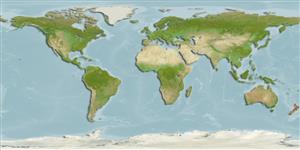Klassifizierung / Names
Namen | Synonyme | Catalog of Fishes(Gattung, Arten) | ITIS | CoL | WoRMS | Cloffa
>
Blenniiformes (Blennies) >
Tripterygiidae (Triplefin blennies) > Tripterygiinae
Etymology: Ruanoho: A vernacular name in maori, New Zealand.
Environment: milieu / climate zone / depth range / distribution range
Ökologie
seewasser benthopelagisch; tiefenbereich 0 - 21 m (Ref. 84086). Subtropical
Southwest Pacific: New Zealand.
Size / Gewicht / Alter
Maturity: Lm ? range ? - ? cm
Max length : 9.0 cm TL Männchen/unbestimmt; (Ref. 84086)
Adults are commonly found in sheltered to moderately exposed areas shallower down to 21 m; less associated with rocky substratum, but may be found under, side or top of rocks. They are found in offshore islands and coastal mainland areas (Ref. 84086). They feed on a range of benthic invertebrates including ophiuroids, archaeogastropods, trichoptera and errant polychaetes (Ref. 84084). Eggs are hemispherical and covered with numerous sticky threads that anchor them in the algae on the nesting sites (Ref. 240). Larvae are planktonic which occur primarily in shallow, nearshore waters (Ref. 94114).
Life cycle and mating behavior
Geschlechtsreife | Fortpflanzung | Ablaichen | Eier | Fecundity | Larven
Wellenreuther, M., C. Syms and K.D. Clements, 2008. Body size and ecological diversification in a sister species pair of triplefin fishes. Evol. Ecol. 22:575-592. (Ref. 84086)
IUCN Rote Liste Status (Ref. 130435)
Bedrohung für Menschen
Harmless
Nutzung durch Menschen
Mehr Information
NamenSynonymeMetabolismusRäuberÖkotoxikologieFortpflanzungGeschlechtsreifeAblaichenSpawning aggregationFecundityEierEientwicklung
Alter/GrößeWachstumLänge-GewichtLänge-LängeLängenhäufigkeitenMorphometrieMorphologieLarvenLarven Pop.Dyn.RekrutierungDichteBRUVS
ReferenzenAquakulturAquakultur ProfilZuchtlinienGenetikElectrophoresesVererbbarkeitKrankheitenVerarbeitungNutrientsMass conversion
PartnerBilderStamps, Coins Misc.LauteCiguateraGeschwindigkeitSchwimmstilKiemenoberflächeOtolithsGehirngrößeSehfähigkeit
Tools
Zusatzinformationen
Download XML
Internet Quellen
Estimates based on models
Preferred temperature (Ref.
123201): 13 - 20.3, mean 16.5 °C (based on 130 cells).
Phylogenetic diversity index (Ref.
82804): PD
50 = 0.7500 [Uniqueness, from 0.5 = low to 2.0 = high].
Bayesian length-weight: a=0.01000 (0.00244 - 0.04107), b=3.04 (2.81 - 3.27), in cm total length, based on all LWR estimates for this body shape (Ref.
93245).
Trophic level (Ref.
69278): 3.3 ±0.4 se; based on size and trophs of closest relatives
Widerstandsfähigkeit (Ref.
120179): hoch, Verdopplung der Population dauert weniger als 15 Monate. (Preliminary K or Fecundity.).
Fishing Vulnerability (Ref.
59153): Low vulnerability (10 of 100).
Nutrients (Ref.
124155): Calcium = 270 [134, 635] mg/100g; Iron = 1.7 [0.8, 3.3] mg/100g; Protein = 17.8 [16.7, 19.0] %; Omega3 = 0.238 [0.102, 0.555] g/100g; Selenium = 28.4 [10.1, 75.9] μg/100g; VitaminA = 17.2 [4.1, 73.9] μg/100g; Zinc = 1.83 [1.08, 2.83] mg/100g (wet weight);
